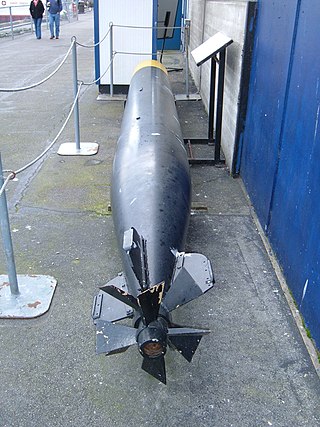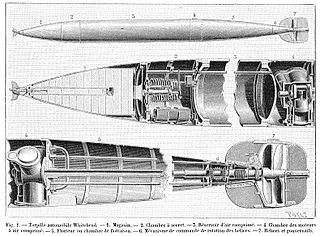
A modern torpedo is an underwater ranged weapon launched above or below the water surface, self-propelled towards a target, and with an explosive warhead designed to detonate either on contact with or in proximity to the target. Historically, such a device was called an automotive, automobile, locomotive, or fish torpedo; colloquially a fish. The term torpedo originally applied to a variety of devices, most of which would today be called mines. From about 1900, torpedo has been used strictly to designate a self-propelled underwater explosive device.

USS Bluefish (SSN-675), a Sturgeon-class attack submarine, was the second ship of the United States Navy to be named for the bluefish.

The Mark 45 anti-submarine torpedo, a.k.a. ASTOR, was a submarine-launched wire-guided nuclear torpedo designed by the United States Navy for use against high-speed, deep-diving, enemy submarines. This was one of several weapons recommended for implementation by Project Nobska, a 1956 summer study on submarine warfare. The 19-inch (480 mm)-diameter torpedo was fitted with a W34 nuclear warhead. The need to maintain direct control over the warhead meant that a wire connection had to be maintained between the torpedo and submarine until detonation. Wire guidance systems were piggybacked onto this cable, and the torpedo had no homing capability. The design was completed in 1960, and 600 torpedoes were built between 1963 and 1976, when ASTOR was replaced by the Mark 48 torpedo.

The Howell Automobile Torpedo was the first self-propelled torpedo produced in quantity by the United States Navy, which referred to it as the Howell Mark I torpedo. It was conceived by Lieutenant Commander John A. Howell, United States Navy, in 1870, using a 60 kg (130 lb) flywheel spun at a very high speed to store energy and drive propellers.

The Mark 37 torpedo is a torpedo with electrical propulsion, developed for the US Navy after World War II. It entered service with the US Navy in the early 1950s, with over 3,300 produced. It was phased out of service key with the US Navy during the 1970s, and the stockpiles were sold to foreign navies.

The Mark 14 torpedo was the United States Navy's standard submarine-launched anti-ship torpedo of World War II. This weapon was plagued with many problems which crippled its performance early in the war. It was supplemented by the Mark 18 electric torpedo in the last two years of the war. From December 1941 to November 1943 the Mark 14 and the destroyer-launched Mark 15 torpedo had numerous technical problems that took almost two years to fix. After the fixes, the Mark 14 played a major role in the devastating blow U.S. Navy submarines dealt to the Japanese naval and merchant marine forces during the Pacific War.

The Mark 15 torpedo, the standard American destroyer-launched torpedo of World War II, was very similar in design to the Mark 14 torpedo except that it was longer, heavier, and had greater range and a larger warhead. It was developed by the Naval Torpedo Station Newport concurrently with the Mark 14 and was first deployed in 1938. It replacement for the Mark 8 torpedo, Mark 11 Torpedo and Mark 12 Torpedo on surface ships with tubes that could accommodate the longer Mark 15; this primarily included destroyers built after 1930. Older destroyers, primarily the Wickes and Clemson classes, continued to use the Mark 8, as did PT boats early in World War II. During the war 9,700 were produced at Newport and at the Naval Ordnance Station Forest Park, Illinois.

The Whitehead torpedo was the first self-propelled or "locomotive" torpedo ever developed. It was perfected in 1866 by Robert Whitehead from a rough design conceived by Giovanni Luppis of the Austro-Hungarian Navy in Fiume. It was driven by a three-cylinder compressed-air engine invented, designed, and made by Peter Brotherhood. Many naval services procured the Whitehead torpedo during the 1870s, including the US Navy. This early torpedo proved itself in combat during the Russo-Turkish War when, on 16 January 1878, the Ottoman ship Intibah was sunk by Russian torpedo boats carrying Whiteheads, though this story has been disputed in one book.

The Mark 16 torpedo was a redesign of the United States Navy's standard Mark 14 torpedo in use during World War II. It incorporated war-tested improvements into a weapon designed to be used in unmodified United States fleet submarines. Due to high unit cost and the Mark 14's unreliability issues being solved by mid-1943, they were never put into mass production.
There have been a number of 18-inch torpedoes in service with the United Kingdom.

The Bliss-Leavitt torpedo was a torpedo designed by Frank McDowell Leavitt and manufactured by the E. W. Bliss Company of Brooklyn, New York. It was put into service by the United States Navy in 1904 and variants of the design would remain in its inventory until the end of World War II.
The Schwartzkopff torpedo was a torpedo manufactured in the late 19th century by the German firm Eisengießerei und Maschinen-Fabrik von L. Schwartzkopff, later known as Berliner Maschinenbau, based on the Whitehead design. Unlike the Whitehead torpedo, which was manufactured out of steel, the Schwartzkopff was made out of bronze, enhancing corrosion resistance.
The Whitehead Mark 1 torpedo was the first Whitehead torpedo adopted by the United States Navy for use in an anti-surface ship role after the E. W. Bliss Company of Brooklyn, New York secured manufacturing rights in 1892. The US Navy made an initial acquisition of 100 Mark 1s, which, by the time they entered American service, were faster, had longer range and carried a larger warhead than Robert Whitehead's earlier models.
The Whitehead Mark 1B torpedo, designated as a Torpedo Type B, was a variant of the Whitehead Mark 1 torpedo adopted by the United States Navy for use in an anti-surface ship role after the E. W. Bliss Company of Brooklyn, New York secured manufacturing rights in 1892. The primary differences between the Mark 1 and the Mark 1B were that the Mark 1B was longer, carried a heavier guncotton charge in the warhead and included an improved guidance system.
The Whitehead Mark 2 torpedo was a Whitehead torpedo adopted by the United States Navy for use in an anti-surface ship role after the E. W. Bliss Company of Brooklyn, New York secured manufacturing rights in 1892. It was identical to the Whitehead Mark 1 torpedo, except for some mechanical details.

The Whitehead Mark 3 torpedo was a Whitehead torpedo adopted by the United States Navy for use in an anti-surface ship role after the E. W. Bliss Company of Brooklyn, New York secured manufacturing rights in 1892.
The Whitehead Mark 5 torpedo was a Whitehead torpedo adopted by the United States Navy for use in an anti-surface ship role in 1910. The Mark 5 was the first torpedo to be manufactured by a foreign company, the Whitehead facility in the United Kingdom, and in 1908, by the Naval Torpedo Station in Newport, Rhode Island. It was also the first torpedo to allow the firing ship to vary its speed and range.
The Bliss-Leavitt Mark 1 torpedo was a Bliss-Leavitt torpedo adopted by the United States Navy for use in an anti-surface ship role after the E. W. Bliss Company of Brooklyn, New York, which had been building Whitehead torpedoes for the US Navy, began designing and manufacturing their own torpedoes in 1904.
The Bliss-Leavitt Mark 2 torpedo was a Bliss-Leavitt torpedo adopted by the United States Navy for use in an anti-surface ship role after the E. W. Bliss Company of Brooklyn, New York, which had been building Whitehead torpedoes for the US Navy, began designing and manufacturing their own torpedoes in 1904. It was the first American-built torpedo to feature counter-rotating turbines, each driving a propeller. This design eliminated the unbalanced torque that contributed to the tendency of its predecessor to roll.

The Short Mark 7 torpedo was a variant of the Bliss-Leavitt Mark 7 torpedo developed by the Washington Navy Yard in order to fit certain submarine torpedo tubes in 1917. The Short Mark 7, also designated Torpedo Type D, had an air flask that was shortened and a reduced warhead weight. The fuel and water tanks were relocated to obtain more air flask capacity; the fuel tank was mounted in the aft air flask bulkhead, while the water tanks were mounted in the after-body. The overall weight of the warshot torpedo was 590 pounds lighter and 58 inches shorter than the Mark 7. The air, fuel and water capacities were approximately one-third of the capacities found on the full-size Mark 7. This torpedo was never produced in quantity.












